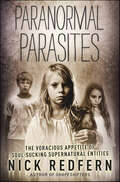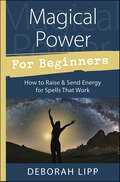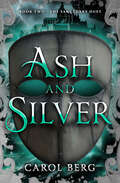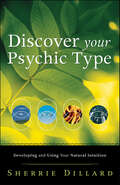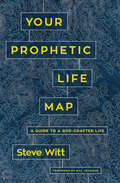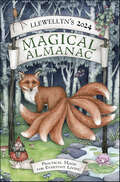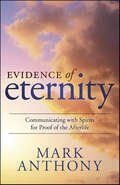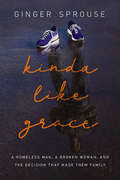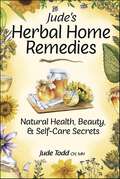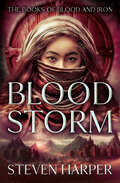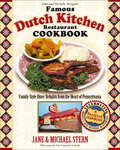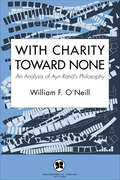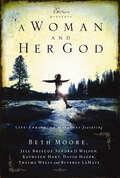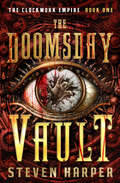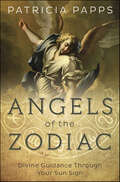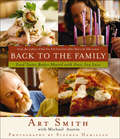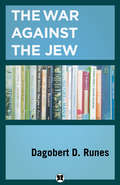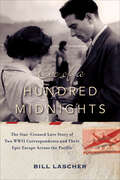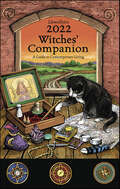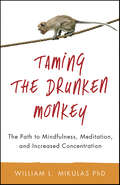- Table View
- List View
Paranormal Parasites: The Voracious Appetite of Soul-Sucking Supernatural Entities
by Nick RedfernThe terrifying truth is that the Earth is one big farm.And to paranormal parasites...we are the cattle.Most people remain oblivious to the truth—there's a monstrous menagerie of supernatural entities that feed upon human victims without our knowledge. Fueling themselves with our psychic energy, high states of emotion, and essential lifeforce, these dark entities attack as we sleep and even in our waking hours, terrifying and tormenting unsuspecting souls whenever and wherever they can.Join Nick Redfern as he delves deep into the long history of struggle between us and them. Learn the ways of Shadow People, supernatural seducers, poltergeists, tulpas, the Slenderman, Men in Black, and many other types of energy creatures. With this exciting book's help, you'll be ready to face the ancient evil that has lurked in the shadows of mankind since the beginning of time.
God Has a Dream for Your Life
by Sheila WalshIt's never too late to remember who you are, it's never too late to dream big dreams and discover that God loves you in ways you cannot yet imagine.Do you dare believe in a God who wants to make your dreams come true? It seems like there is no time to dream these days. Yet the Bible is full of dreamers?those who exchanged their old dreams for new ones, and those who received unexpected dreams from God that changed the course of history. Best-selling author Sheila Walsh gives warm hearted stories of real people, interwoven with biblical insight, to help you discover God's dream for your life.
Magical Power For Beginners: How to Raise & Send Energy for Spells That Work
by Deborah LippDiscover easy ways to harness the power of magic with this accessible guidebook.What makes magic work? What can it do and what can’t it do? This straightforward, easy-to-follow guide answers the most common questions about magical power. By learning the fundamentals of raising and sending power, you’ll gain the skills you need to create and perform spells and rituals that work. Written for beginners or adepts from any spiritual background, this approachable book shows how to:Personalize power to suit your purposeChoose a magical goalUse magical correspondencesStore power in your toolsTranscend time and spacePerform group magicConstruct a spell (with step-by-step samples)Develop mind skills (meditation, grounding, and visualization)
Ash and Silver (The Sanctuary Duet)
by Carol BergIn this epic fantasy sequel to Dust and Light, a man without a past must restore his memory to save his kingdom. As a candidate for knighthood in the Order of the Equites Cineré, Greenshank had to give up his memory. It also means thinking of the past makes his head ache, but that hasn&’t stopped him from putting in two years of rigorous training. He is almost ready to embrace the order&’s mission—to use selfless magic to heal the fractured kingdom of Navronne. Still, trouble arises on his first solo assignment when he encounters a mysterious woman who brings his past rushing back . . . Greenshank discovers he was once a sorcerer with a different name. One whose gifts threaten the safety of the kingdom and the world. Now to unravel the mysteries of his past and his powers, he must trace a path of corruption that leads into some unexpected—and dangerous—places . . . &“Berg has an artist&’s touch with fantasy worlds and scenes.&” —RT Book Reviews &“With this masterful opening . . . the story grabs you by the hand, plunging you headfirst into a world of magic and war, where nothing is quite what it seems.&” —San Francisco Book Review &“I particularly enjoyed the structure and logic of the story, but it is the character Greenshanks that kept me reading. I wanted to go on the journey with him to recapture his lost memories and to see why he was so important to his world. The emotional nexus around him was compelling and the world he inhabited was one I could live in.&” —King&’s River Life Magazine
Discover Your Psychic Type: Developing and Using Your Natural Intuition
by Sherrie DillardIntuition and spiritual growth are inherently linked, according to professional psychic and therapist Sherrie Dillard. This groundbreaking guide offers a personalized approach to spiritual development, introducing four different psychic types and revealing how to develop the unique talents of each. Designed for both beginning intuitives and advanced psychics, this book presents a simple, step-by-step plan:Take the insightful quiz to learn whether you are a physical, mental, emotional, or spiritual intuitiveDiscover more about each type's nature, personality, strengths, and potential challengesDevelop your psychic abilities with the meditations and exercises designed for your specific intuitive styleThroughout the book, Dillard shares remarkable stories from her professional practice to illustrate the incredible power of intuition and its connection to the spirit world, inner wisdom, and your higher self.
Angel Intuition: A Psychic's Guide to the Language of Angels
by Tanya Carroll RichardsonLearn how to improve your intuition from a professional intuitive!In Angel Intuition, psychic and angel expert Tanya Carroll Richardson teaches you about your sixth sense so you can receive more divine guidance to improve every area of your life.Tanya picks up where she left off in her first bestselling angel book, Angel Insights, offering even more information about angels and other members of your spiritual guidance squad—spirit animals, ascended masters like Buddha and Mother Mary, loved ones who've passed on, and your soul's own higher self. Tanya shares how she discovered and honed her intuitive gifts and gives you the knowledge and practical exercises to understand and develop your abilities as well.Find out how we receive information via the four clairs (clairaudience, clairvoyance, claircognizance, and clairsentience). Take a quiz to help you get more in touch with your sensitivity and to learn where you fall on the intuition spectrum. Discover the eleven most common ways that angels send you guidance, learn Tanya's twenty-five golden rules of intuition, and receive clues about your own past lives, soul archetypes, and current destiny. Take your intuition to the next level with this fun, informative, encouraging book.
Your Prophetic Life Map: A Guide to a God-Crafted Life
by Steve WittLooking for direction in your life?Ever wonder how God is working in you and around you?Join pastor and trainer Steve Witt as he helps you locate the intersection where our passions and personal currencies meet—your sweet spot—and in the process discover where God has been at work all along. Partnering with God&’s Spirit in these ways will breed a deep sense of inner peace and cause your faith to grow.You will begin to recognize God&’s hand in your past, your present, and see how He is plotting a course for your future.Complete with interactive charts and guides, Your Prophetic Life Map will become the go-to instrument in your spiritual development.Steve will show you how a lifetime of encounters with God can shape your destiny.You will learn to:view your pain as a guidework your way out of immovable moments in lifespot Spirit-led opportunitiesnavigate life&’s eight great choicessee the art of planning as an act of faith
Llewellyn's 2024 Magical Almanac: Practical Magic for Everyday Living
by LlewellynFor over three decades, this almanac has provided spells, rituals, and ideas that inspire practitioners of all levels to deepen their magical practice. You'll enjoy two dozen articles, grouped by element, that improve your connection to natural energies and enrich your life throughout the year. Well-known contributors offer their insights on many topics, including:Egg Magic • Uncrossing Spells • Ozark Protection Magic • Yoga for Sleep • Magical Infusions • Herbal Allies for Astrological Transits • Working with Local SpiritsYou'll also find a section on coloring magic, three spells to accompany the coloring pages, a calendar section with numerous holidays and correspondences, and more.
Science Fiction: Exploring the Craft of Science Fiction
by Robert SilverbergThe Grand Master details his development as a writer and shares thirteen favorite sci-fi stories from his youth and what they taught him about writing. Every writer must start somewhere. Robert Silverberg was once simply a young man learning the art and craft of writing before he found success. But how did he get from there to winning four Hugo Awards, three Locus Awards, and six Nebula Awards, as well as being named a Grand Master of science fiction? In Science Fiction 101, the prolific author looks back to his roots in the genre to answer that question. With thought-provoking essays, Silverberg details the inspiration, lessons, strategies, and skills he gained from thirteen groundbreaking science fiction stories from the 1940s, &’50s, and &’60s—all included in this volume. It&’s an entertaining and enlightening read, perfect for those interested in sci-fi history and the craft of writing. Featuring thirteen classic stories from Brian W. Aldiss, Alfred Bester, James Blish, Philip K. Dick, Damon Knight, Cyril M. Kornbluth, Henry Kuttner, C. L. Moore, Frederik Pohl, Bob Shaw, Robert Sheckley, Cordwainer Smith, and Jack Vance. Previously published as Robert Silverberg&’s Worlds of Wonder Praise for Science Fiction 101 &“An excellent introduction to the most important roots of modern SF.&” —The Washington Post &“Offers encouragement and sound counsel . . . Anyone interested in writing science fiction and fantasy will profit from this book.&” —San Francisco Examiner-Chronicle &“A virtual primer on the writing of science fiction . . . a fascinating portrait of a young man becoming a writer . . . Finally, we have the 13 stories, almost all of which are classics in the field, wonderful to reread and in some cases to encounter for the first time.&” —Publishers Weekly &“A unique and successful work.&” —Los Angeles Times
Evidence of Eternity: Communicating with Spirits for Proof of the Afterlife
by Mark AnthonyDiscover the enlightening and comforting true stories of Mark Anthony the Psychic Lawyer® as he helps people communicate with their loved ones in spirit. Evidence of Eternity is an uplifting journey that removes the fear and superstition surrounding spirit contact while addressing poignant questions about the afterlife. It provides insights on painful subjects such as crime, homicide, suicide, and survivor guilt.By bridging the gap between the spiritual and scientific, this groundbreaking book brings spirit communication into the modern era while reaffirming that God and heaven exist, the soul is an immortal living spirit, and that we will be reunited with our deceased loved ones. Evidence of Eternity introduces new and innovative terms and concepts explaining spirit communication based on science, theoretical physics, physiology, theology, and evidence. From karma and reincarnation to embracing the inner light, Evidence of Eternity is a cutting-edge perspective of life after death.Watch Mark Anthony discuss Evidence of Eternity here.Praise:"Mark Anthony the Psychic Lawyer® is exceptionally qualified to write about the afterlife: he is a renowned psychic medium and attorney who presents powerful evidence that deceased loved ones can communicate with us. The insights are powerful, inspiring, and could change your life."—Dr. Jeffrey Long, author of Evidence of the Afterlife: The Science of Near-Death Experiences"Evidence of Eternity is an absolutely riveting book, full of highly evidential, fascinating cases and much spiritual wisdom. Five stars plus!"—Dr. Kenneth Ring, author of Lessons from the Light"A riveting book that opens your heart and mind to the reality of the afterlife. This book is unforgettable, and its messages are empowering. Read this right now!"—Dr. Joe Vitale, author of Zero Limits and star of The Secret"Addresses murder, suicide, death of children, and unresolved family issues with a mix of passion and logic like no other."—William Buhlman of the Monroe Institute for Out of Body Experiences"Evidence of Eternity logically explains the afterlife, all the while demonstrating that faith and science are not mutually exclusive."—Deborah King, author of Be Your Own Shaman and Truth Heals"Evidence of Eternity is provocative, stirring, endearing, and hopeful. For a guide to strong spiritual connection and means to personal discovery, this is a book you want to read."—Dr. My Haley, widow of Alex Haley and collaborator on his New York Times bestseller Roots
Kinda Like Grace: A Homeless Man, a Broken Woman, and the Decision That Made Them Family
by Ginger SprouseThe inspirational story of how a woman with a difficult past befriended a homeless man whose kind, life-affirming spirit taught her and their Texas community about forgiveness, humility, and the boundless love of God.Stopped at a familiar Houston intersection on her way to work, Ginger Sprouse watched the homeless man pacing the garbage-strewn ground in his bare feet. Compelled to pull over and say hello, she was drawn to his exuberant joy and infectious smile. Over the next few months, she would learn that Victor, who was mentally disabled, had been returning to that spot because it was the last place he had seen his mother--three years earlier.Motivated by her faith and their deepening friendship, Ginger set out to help Victor, creating Facebook and GoFundMe pages to raise funds for Victor's medications, clothing, and food. When it became clear that he could not live safely on his own, she and her family took a leap of faith and offered him a permanent place in their family. What Ginger learned from Victor about forgiveness, humility, and love changed her forever. Kinda Like Grace is a powerful reminder that seemingly insurmountable obstacles can be overcome, that we all deserve second chances, and that each of us has a limitless capacity to love our neighbors, no matter how different from us they may appear to be.
Jude's Herbal Home Remedies: Natural Health, Beauty & Self-Care Secrets
by Jude C. ToddDiscover a simpler, more natural way of life. Pour yourself a cup of chamomile tea, find a quiet corner, and browse through the wealth of natural remedies, household tips, and beauty secrets presented in this tried and true guidebook. Now updated and expanded, Jude's Herbal Home Remedies offers more than 800 treatments, tinctures, tonics, and teas, using many easy-to-find herbs, as well as a comprehensive herbal index with over 200 illustrations.
Blood Storm (The Books of Blood and Iron)
by Steven HarperA half-troll and his companions must recover a forgotten magic to rescue their friends in this epic fantasy adventure by the author of Iron Axe. Danr the half-troll saved the kingdom of Erda from destruction and restored peace to the realm. His own life, however, is far from peaceful. Going out in public, he draws attention from fans and from those who still see him as an evil half-breed. When he learns of a people who once wielded the power of the shape, he dreams of becoming fully human and settling down on a quiet farm with his beloved. But others would like to possess such magic. Slavers abduct Danr&’s friends, ransoming them for the power of the shape. Now Danr, Aisa, and their friend, Talfi the undying, must embark on a perilous quest that will force them to confront the Fates, Death, and a giant wyrm that dwells at the bottom of the sea. If he hopes to survive, Danr must become the hero he is so reluctant to be . . .Praise for Iron Axe &“[Harper&’s] reinterpretations of trolls, giants, and fae folk give this series opener a fresh feeling, while his nods to Norse mythology and folklore root it strongly in fantasy tradition. Readers will be eager to see what&’s in store for Aisa and Danr.&” —Publishers Weekly &“Steven Harper created a world that I never got tired of exploring.&” —The Qwillery &“The story holds all of the adventure, magic, and mystery I have come to expect from the genre. . . . [It] follows a hero&’s journey . . . with energy and artfulness.&” —Wicked Little Pixie
John and Michelle Morgan's Famous Dutch Kitchen Restaurant Cookbook: Family-Style Diner Delights from the Heart of Pennsylvania (Roadfood Cookbooks)
by Jane Stern Michael SternPart diner, part family-style restaurant, the Famous Dutch Kitchen Restaurant in Frackville, Pennsylvania, north of Lancaster County, serves up some of the best food in this popular tourist area visited by more than five million people each year. Feast on turkey pot pie, ham and cabbage casserole, and delicious vegetables. The cornbread is moist, flavorful, and nearly as sweet as cake. And top it all off with shoofly pie or the Famous Dutch Kitchen's signature Atomic Banana Split. Pennsylvania Dutch Country is a land of rolling farmlands dotted with one-room schoolhouses where you will encounter horse-drawn buggies, beautiful quilts, and industrious "Plain People." The Famous Dutch Kitchen Restaurant is the seventh restaurant to be chosen by authors Jane and Michael Stern for their Roadfood cookbook series which celebrates the finest regional restaurants in the United States. It includes an 8-page color insert.Previous Roadfood cookbooks include:Blue Willow Inn Cookbook-1-55853-991-3El Charo Cookbook-1-55853-992-1Durgin Park Cookbook-1-4016-0028-X Harry Carey's Cookbook-1-4016-0095-6Louie's Backyard Cookbook-1-4016-0038-7Carbone's Cookbook-1-4016-0122-7
With Charity Toward None: An Analysis of Ayn Rand's Philosophy
by William F. O'NeillAn in-depth and evenhanded examination of Ayn Rand&’s philosophy as expressed in her novels and nonfiction writings. In With Charity Toward None, William F. O&’Neill addresses the fundamentals of objectivism and the full meaning of an objectivist point of view. He delves into the social implications of putting such a philosophy into action. Neither fawning nor dismissive, O&’Neill forgoes the popular controversy surrounding Rand, focusing instead on rational and semantic analysis of her work. Divided into two major sections, the first part of this book summarizes the three basic areas of Randian philosophical inquiry: (1) knowing and the known, (2) personal value and the nature of man, and (3) the ethics of objectivism. The second part consists primarily of a critical analysis of the ideas presented in the earlier pages.
To Ride a Silver Broomstick: New Generation Witchcraft
by Silver RavenWolfThis popular guide has been helping a new generation of Witches—those practicing or wishing to practice the Craft on their own—for decades. Summon. Scry. Spin, spiral, and sweep. Learn how to bend time, draw down the moon’s energy, and use mirror magick. Whether novice or adept, a Witch’s world is filled with wonder and magick. It’s also filled with the hard work and dedication to learning that are part of living the Craft every day. Silver RavenWolf presents a fascinating introduction to the Craft in To Ride a Silver Broomstick, the first volume in the tremendously popular Witchcraft series that also includes To Stir a Magick Cauldron and To Light a Sacred Flame. This indispensable guide presents tried-and-true Witch wisdom, dished out with Silver’s down to earth warmth and humor. You’ll learn the essentials of Witchcraft, including: WebweavingAural projection, bilocation, and power animalsStocking your magickal cabinetCleaning, consecrating, and chargingThe Summerland death, reincarnation, and timeFinding your magickal nameHealing techniquesDeities and pantheonTelepathy, psychometry, and mind powerThe Wheel of the YearGems, herbs, and healingColor, candle, and sympathetic magick
A Woman and Her God: Life-Enriching Messages (Extraordinary Women)
by Beth Moore Jill Briscoe Kathleen Hart Sandra D. WilsonLife-changing messages from today’s most trusted Christian communicators on how women can experience intimacy with God.Many of today’s most extraordinary Christian women communicators join together to impart the wisdom God has given them—and to help women realize all God intended for them. Features Jill Briscoe, Beth Moore, Sandra D. Wilson, Kathleen Hart, David Hager, Thelma Wells, and Beverly LaHaye.“‘You don’t have to get your act together, lose ten pounds . . . write a best-selling book, or raise perfect children’—God loves you anyway. So begins this collection of writings by Christian authors, which focuses on how a close relationship with God improves a woman’s life in myriad ways . . . Women looking for spiritual sustenance will find comfort in these pages, as the authors share personal problems and triumphs as well as their passionate commitment to a closer relationship with God.” —Publishers Weekly
The Doomsday Vault (The Clockwork Empire)
by Steven HarperA noblewoman and an airship pilot fight zombies, mad scientists, and more in this steampunk adventure series debut by the author of Iron Axe. A bizarre strain of zombies roam the streets of Victorian London, infecting all they touch with the Clockwork Plague. While most victims die painful deaths, a few become Clockworkers, geniuses who create the greatest inventions of the age—right before going insane. The plague has also taken its toll on the life of twenty-two-year-old Alice Michaels. After her mother and brother die from the disease because of her, she feels obligated to ensure her father&’s happiness. Unfortunately, that means ignoring her passion for automatons and instead, pursuing the wealthiest man possible. But when zombies attack Alice&’s cab, being tied down in a loveless marriage is the least of her worries. She is quickly swept up into a secret organization chasing down Clockworkers—and into the arms of Gavin Ennock, a former airship cabin boy and talented fiddle player. Together they will navigate a political conspiracy that threatens to consume their country and the world . . . &“If you love your Victorian adventures filled with zombies, amazing automatons, steampunk flare, and an impeccable eye for detail, you&’ll love the fascinating (and fantastical) Doomsday Vault!&” —My Bookish Ways &“Harper creates a fascinating world of devices, conspiracies, and personalities. . . . Alice and Gavin fight to survive and to find love in this steampunk coming-of-age story. Harper&’s world building is well developed and offers an interesting combination of science and steam.&” —SFRevu &“A goofy excursion in a style reminiscent of Foglios&’s Girl Genius graphic series. . . . A highly entertaining romp.&” —Locus
Angels of the Zodiac: Divine Guidance Through Your Sun Sign
by Patricia PappsOpen yourself to the love and wisdom of the angels of your sun sign, who reveal your life's purpose and show you how to live harmoniously each day. Angels of the Zodiac organizes the angels by the sun sign they're associated with, allowing you to easily determine which ones to connect with throughout the year.Tuning in to zodiac angels when their sign is strongest makes them more powerful, and they can use that boost to send miracles into your life. You can even connect to angels outside your sun sign at strategic times to benefit from their different energies. This book provides a meditation for connecting with each angel, guiding you through the process and the benefits that accompany it. With angels by your side, you'll achieve greater love, inspiration, and fulfillment.
Back to the Family: Food Tastes Better Shared with Ones You Love
by Art Smith Michael AustinBack to the Family is a companion to Art Smith's New York Times bestseller and James Beard award-winning cookbook, Back to the Table. Smith is the personal chef to Oprah Winfrey and a contributing editor to O Magazine.This book encourages readers to better understand the importance of valuing the ones you love through cooking and communing with food. Most importantly Back to the Family stresses the importance of recognizing old food traditions (family recipes, meals, memories, etc.) and the equal importance of creating new and healthier food traditions. More than 150 recipes and more than 140 photographs provide a wonderful evocative eating and reading experience.
The War Against the Jew
by Dagobert D. RunesAn A-to-Z reference guide to the major figures, concepts, and events factoring into antisemitic hatred and violence across history. In The War Against the Jews, Dagobert D. Runes presents a scholarly account of antisemitism across centuries of war, slander, atrocities, and bigotry as it has manifested around the world. Concise entries cover everything from major figures of the Catholic Church who endorsed hate to code names for little-known Nazi plans. Here, readers can learn how Russian emperor Alexander I expelled Jews from Russian towns in the nineteenth century, a fifteenth-century Franciscan friar travelled through Europe spreading fear of Jews as baby killers, the ominous prayer recited by Protestant and Catholic bishops on Hitler&’s fiftieth birthday, and much more.
Checklist for Life for Men: Timeless Wisdom & Foolproof Strategies for Making the Most of Life's Challenges & Opportunities
by Thomas NelsonChecklist for Life is the ultimate handbook for living a successful, joy-filled life. This follow-up title, Checklist for Life for Men, offers insight into topics and issues that are specific to men's interests.Each interactive chapter of the handbook contains:A brief narrativeAn "I Will" checklist of heart and attitude reinforcements.A "Things to Do" checklist of action points.A "Things to Remember" section of Scripture verses and applicable quotes from famous and not-so-famous people.Topics addressed include work, integrity, and marriage. In all, the book addresses 66 topics men care about. And the handsome, sturdy package and attractive design make Checklist for Life for Men an ideal gift.
Eve of a Hundred Midnights: The Star-Crossed Love Story of Two WWII Correspondents and Their Epic Escape Across the Pacific
by Bill LascherThe unforgettable true story of two married journalists on an island-hopping run for their lives across the Pacific after the Fall of Manila during World War II—a saga of love, adventure, and danger.On New Year’s Eve, 1941, just three weeks after the attack on Pearl Harbor, the Japanese were bombing the Philippine capital of Manila, where journalists Mel and Annalee Jacoby had married just a month earlier. The couple had worked in China as members of a tight community of foreign correspondents with close ties to Chinese leaders; if captured by invading Japanese troops, they were certain to be executed. Racing to the docks just before midnight, they barely escaped on a freighter—the beginning of a tumultuous journey that would take them from one island outpost to another. While keeping ahead of the approaching Japanese, Mel and Annalee covered the harrowing war in the Pacific Theater—two of only a handful of valiant and dedicated journalists reporting from the region.Supported by deep historical research, extensive interviews, and the Jacobys’ personal letters, Bill Lascher recreates the Jacobys’ thrilling odyssey and their love affair with the Far East and one another. Bringing to light their compelling personal stories and their professional life together, Eve of a Hundred Midnights is a tale of an unquenchable thirst for adventure, of daring reportage at great personal risk, and of an enduring romance that blossomed in the shadow of war.
Llewellyn's 2022 Witches' Companion: A Guide to Contemporary Living
by LlewellynWith more than two dozen enlightening and inspiring articles that explore modern Witchcraft topics and magical techniques, Llewellyn's 2022 Witches' Companion is a must-have for today's practitioners. This collection presents some of the finest writers and compelling subjects that will empower your life and improve your community.
Taming the Drunken Monkey: The Path to Mindfulness, Meditation, and Increased Concentration
by William L. MikulasIn today's busy world, the mind can often behave like a drunken monkey—stressed, scattered, and out of control. Instead of falling victim to frustration and anxiety, learn to be calm, focused, and free of unwanted thoughts with this easy-to-use guide to mindfulness.Drawing from Western and Eastern psychology, health systems, and wisdom traditions, Taming the Drunken Monkey provides comprehensive instruction for developing and improving three basic behaviors of the mind: concentration, awareness, and flexibility. Discover the power of breathwork exercises based on yogic pranayama, Chinese medicine, and Western respiratory science. Apply meditation and other mindfulness practices to your life for newfound focus, creativity, body awareness, and spiritual awakening. As you progress from novice to master, you'll effectively enhance the health of your mind, body, and spirit.Praise:"A wonderful addition to our understanding of the mind and the unfolding journey of discovery."—Joseph Goldstein, author of Mindfulness: A Practical Guide to Awakening"In fluid and engaging prose, William Mikulas has written a book that provides a wise and delightful guide to living a mindful life...a helpful, systematic and very practical guide that presents numerous insights and exercises for personal transformation."—Nirbhay N. Singh, editor of Mindfulness journal"This book is brimming with wise and compassionate council for everyone from beginner to advanced practitioner...Whether you are interested in quieting your mind, increasing awareness, reducing attachments or opening the heart, you will find just what you need as you continue on your path towards awakening."—Michael Brant DeMaria, PhD, clinical psychologist and author of Ever Flowing On"This is, undoubtedly, one of the best mind training manuals that has ever been written...It is a must read book."—Sompoch Iamsupasit, PhD, professor at Chulalongkorn University in Bangkok"For everybody who wants to be aware and mindful, attentive and concentrated...Bill Mikulas' book is wholeheartedly recommended."—G.T. Maurits Kwee, PhD, founder of the Institute for Relational Buddhism & Karma Transformation
